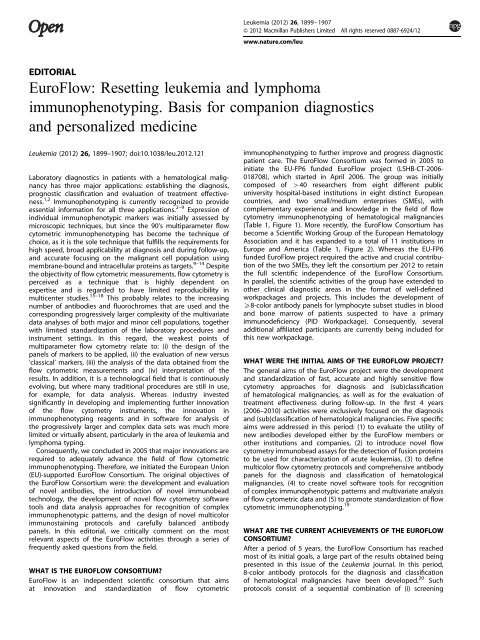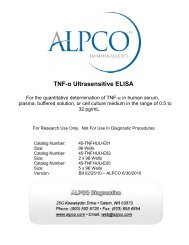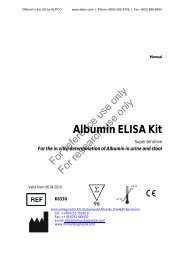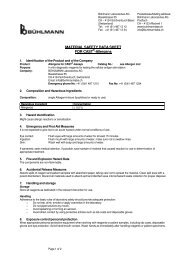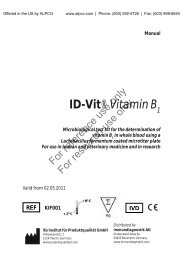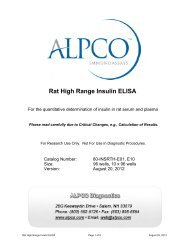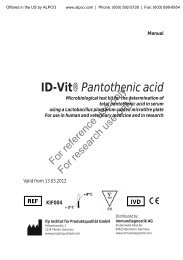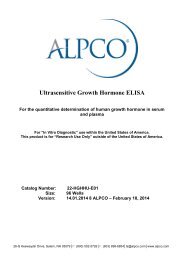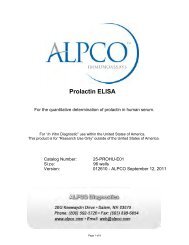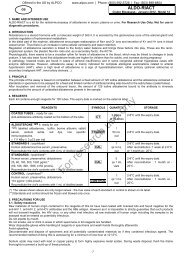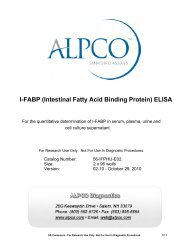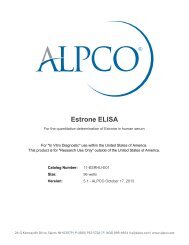EuroFlow - ALPCO Diagnostics
EuroFlow - ALPCO Diagnostics
EuroFlow - ALPCO Diagnostics
You also want an ePaper? Increase the reach of your titles
YUMPU automatically turns print PDFs into web optimized ePapers that Google loves.
Leukemia (2012) 26, 1899–1907<br />
& 2012 Macmillan Publishers Limited All rights reserved 0887-6924/12<br />
www.nature.com/leu<br />
EDITORIAL<br />
<strong>EuroFlow</strong>: Resetting leukemia and lymphoma<br />
immunophenotyping. Basis for companion diagnostics<br />
and personalized medicine<br />
Leukemia (2012) 26, 1899–1907; doi:10.1038/leu.2012.121<br />
Laboratory diagnostics in patients with a hematological malignancy<br />
has three major applications: establishing the diagnosis,<br />
prognostic classification and evaluation of treatment effectiveness.<br />
1,2 Immunophenotyping is currently recognized to provide<br />
essential information for all three applications. 2–9 Expression of<br />
individual immunophenotypic markers was initially assessed by<br />
microscopic techniques, but since the 90’s multiparameter flow<br />
cytometric immunophenotyping has become the technique of<br />
choice, as it is the sole technique that fulfills the requirements for<br />
high speed, broad applicability at diagnosis and during follow-up,<br />
and accurate focusing on the malignant cell population using<br />
membrane-bound and intracellular proteins as targets. 9–14 Despite<br />
the objectivity of flow cytometric measurements, flow cytometry is<br />
perceived as a technique that is highly dependent on<br />
expertise and is regarded to have limited reproducibility in<br />
multicenter studies. 15–18 This probably relates to the increasing<br />
number of antibodies and fluorochromes that are used and the<br />
corresponding progressively larger complexity of the multivariate<br />
data analyses of both major and minor cell populations, together<br />
with limited standardization of the laboratory procedures and<br />
instrument settings. In this regard, the weakest points of<br />
multiparameter flow cytometry relate to: (i) the design of the<br />
panels of markers to be applied, (ii) the evaluation of new versus<br />
‘classical’ markers, (iii) the analysis of the data obtained from the<br />
flow cytometric measurements and (iv) interpretation of the<br />
results. In addition, it is a technological field that is continuously<br />
evolving, but where many traditional procedures are still in use,<br />
for example, for data analysis. Whereas industry invested<br />
significantly in developing and implementing further innovation<br />
of the flow cytometry instruments, the innovation in<br />
immunophenotyping reagents and in software for analysis of<br />
the progressively larger and complex data sets was much more<br />
limited or virtually absent, particularly in the area of leukemia and<br />
lymphoma typing.<br />
Consequently, we concluded in 2005 that major innovations are<br />
required to adequately advance the field of flow cytometric<br />
immunophenotyping. Therefore, we initiated the European Union<br />
(EU)-supported <strong>EuroFlow</strong> Consortium. The original objectives of<br />
the <strong>EuroFlow</strong> Consortium were: the development and evaluation<br />
of novel antibodies, the introduction of novel immunobead<br />
technology, the development of novel flow cytometry software<br />
tools and data analysis approaches for recognition of complex<br />
immunophenotypic patterns, and the design of novel multicolor<br />
immunostaining protocols and carefully balanced antibody<br />
panels. In this editorial, we critically comment on the most<br />
relevant aspects of the <strong>EuroFlow</strong> activities through a series of<br />
frequently asked questions from the field.<br />
WHAT IS THE EUROFLOW CONSORTIUM?<br />
<strong>EuroFlow</strong> is an independent scientific consortium that aims<br />
at innovation and standardization of flow cytometric<br />
immunophenotyping to further improve and progress diagnostic<br />
patient care. The <strong>EuroFlow</strong> Consortium was formed in 2005 to<br />
initiate the EU-FP6 funded <strong>EuroFlow</strong> project (LSHB-CT-2006-<br />
018708), which started in April 2006. The group was initially<br />
composed of 440 researchers from eight different public<br />
university hospital-based institutions in eight distinct European<br />
countries, and two small/medium enterprises (SMEs), with<br />
complementary experience and knowledge in the field of flow<br />
cytometry immunophenotyping of hematological malignancies<br />
(Table 1, Figure 1). More recently, the <strong>EuroFlow</strong> Consortium has<br />
become a Scientific Working Group of the European Hematology<br />
Association and it has expanded to a total of 11 institutions in<br />
Europe and America (Table 1, Figure 2). Whereas the EU-FP6<br />
funded <strong>EuroFlow</strong> project required the active and crucial contribution<br />
of the two SMEs, they left the consortium per 2012 to retain<br />
the full scientific independence of the <strong>EuroFlow</strong> Consortium.<br />
In parallel, the scientific activities of the group have extended to<br />
other clinical diagnostic areas in the format of well-defined<br />
workpackages and projects. This includes the development of<br />
X8-color antibody panels for lymphocyte subset studies in blood<br />
and bone marrow of patients suspected to have a primary<br />
immunodeficiency (PID Workpackage). Consequently, several<br />
additional affiliated participants are currently being included for<br />
this new workpackage.<br />
WHAT WERE THE INITIAL AIMS OF THE EUROFLOW PROJECT?<br />
The general aims of the <strong>EuroFlow</strong> project were the development<br />
and standardization of fast, accurate and highly sensitive flow<br />
cytometry approaches for diagnosis and (sub)classification<br />
of hematological malignancies, as well as for the evaluation of<br />
treatment effectiveness during follow-up. In the first 4 years<br />
(2006–2010) activities were exclusively focused on the diagnosis<br />
and (sub)classification of hematological malignancies. Five specific<br />
aims were addressed in this period: (1) to evaluate the utility of<br />
new antibodies developed either by the <strong>EuroFlow</strong> members or<br />
other institutions and companies, (2) to introduce novel flow<br />
cytometry immunobead assays for the detection of fusion proteins<br />
to be used for characterization of acute leukemias, (3) to define<br />
multicolor flow cytometry protocols and comprehensive antibody<br />
panels for the diagnosis and classification of hematological<br />
malignancies, (4) to create novel software tools for recognition<br />
of complex immunophenotypic patterns and multivariate analysis<br />
of flow cytometric data and (5) to promote standardization of flow<br />
cytometric immunophenotyping. 19<br />
WHAT ARE THE CURRENT ACHIEVEMENTS OF THE EUROFLOW<br />
CONSORTIUM?<br />
After a period of 5 years, the <strong>EuroFlow</strong> Consortium has reached<br />
most of its initial goals, a large part of the results obtained being<br />
presented in this issue of the Leukemia journal. In this period,<br />
8-color antibody protocols for the diagnosis and classification<br />
of hematological malignancies have been developed. 20 Such<br />
protocols consist of a sequential combination of (i) screening
1900<br />
Table 1.<br />
List of initial and current <strong>EuroFlow</strong> members<br />
Editorial<br />
Initial <strong>EuroFlow</strong> members (April, 2006) Current <strong>EuroFlow</strong> members (January, 2012)<br />
Institute Senior scientist Other participants Institute Senior scientist Other participants<br />
Erasmus MC,<br />
Rotterdam, NL<br />
University of<br />
Salamanca, ES<br />
Dynomics,<br />
Rotterdam, NL<br />
Cytognos,<br />
Salamanca, ES<br />
Instituto Medicina<br />
Molecular, Lisbon, PT<br />
University of<br />
Schleswig-Holstein –<br />
Campus Kiel, DE<br />
Hôpital Necker-<br />
Enfants Malades,<br />
Paris, FR<br />
St James University<br />
Hospital, Leeds, UK<br />
Charles University,<br />
Prague, CZ<br />
Medical University of<br />
Silesia, Zabrze, PL<br />
JJM van Dongen<br />
A Orfao<br />
VHJ van der Velden, J te<br />
Marvelde, H Wind, B van<br />
Bodegom<br />
JF San Miguel, J Almeida,<br />
J Flores-Montero, MB Vidriales,<br />
JJ Pérez-Morán, Q Lecrevisse<br />
Erasmus MC, Rotterdam,<br />
NL<br />
University of Salamanca,<br />
ES<br />
F Weerkamp K Brouwer-de Cock Instituto Portugues de<br />
Oncologia, Lisbon, PT<br />
M Martín-Ayuso<br />
A Parreira<br />
M Kneba<br />
J Hernández, M Muñoz,<br />
J Bensadón<br />
P Lucio, M Gomes da Silva,<br />
J Parreira, A Mendonc¸a<br />
S Böttcher, M Ritgen,<br />
MBrüggemann, V Krull<br />
University of Schleswig-<br />
Holstein – Campus Kiel,<br />
DE<br />
Hôpital Necker-Enfants<br />
Malades, Paris FR<br />
Charles University,<br />
Prague, CZ<br />
E Macintyre L Lhermitte, V Asnafi Medical University of<br />
Silesia, Zabrze, PL<br />
S Richards<br />
J Trka<br />
AC Rawstron, PA Evans,<br />
R de Tute, M Cullen<br />
J Hrusak, T Kalina, E Mejstrikova,<br />
M Vaskova<br />
Federal University of Rio<br />
de Janeiro, BR<br />
Dutch Childhood<br />
Oncology Group,<br />
The Hague, NL<br />
JJM van<br />
Dongen<br />
A Orfao<br />
P Lucio<br />
M Kneba<br />
E Macintyre<br />
J Trka<br />
T Szczepanski<br />
CE Pedreira<br />
E Sonneveld<br />
VHJ van der Velden, AW<br />
Langerak, J te Marvelde,<br />
H Wind, B van Bodegom,<br />
WM Comans-Bitter<br />
JF San Miguel, J Almeida,<br />
J Flores-Montero, MB Vidriales,<br />
JJ Pérez-Morán, Q Lecrevisse<br />
M Gomes da Silva, J Caetano,<br />
T Faria<br />
S Böttcher, M Ritgen, M<br />
Brüggemann, E Harbst, L Falck<br />
L Lhermitte, V Asnafi, A<br />
Trinquand<br />
J Hrusak, T Kalina, E Mejstrikova,<br />
V Kanderova, D Thũrner<br />
L Sędek, J Bulsa, A Sonsala<br />
ES da Costa<br />
T Szczepanski L Sędek University Hospital N Boeckx<br />
Gasthuisberg, Leuven, BE<br />
University of Porto, PT M Lima AH Santos<br />
AJ van der Sluijs-Gelling,<br />
A Koning-Goedheer<br />
Abbreviations: BE, Belgium; BR, Brazil; CZ, Czech Republic; DE, Germany; ES, Spain; FR, France; NL, The Netherlands; PL, Poland; PT, Portugal; UK, United<br />
Kingdom.<br />
Figure 1. <strong>EuroFlow</strong> members attending the first <strong>EuroFlow</strong> meeting held in Salamanca (April, 2006).<br />
tubes adapted to address distinct clinical questions and specific<br />
medical indications of immunophenotyping and (ii) multi-tube<br />
panels for the diagnosis and classification per disease category.<br />
The development of the new 8-color protocols was paralleled<br />
by a set of standard operating procedures (SOP) 21 to assure<br />
full technical standardization of multicolor flow cytometry based<br />
on 3-laser flow cytometry instruments, selection of appropriate<br />
fluorochromes, standardization of instrument settings and<br />
laboratory protocols, and detailed testing and comparison of<br />
antibody clones and fluorochrome-conjugated antibodies<br />
from multiple companies. 20 For this purpose, development and<br />
implementation of new software tools for fast and easy handling<br />
of large data files, 22,23 combining multiple tubes and mapping of<br />
leukemia samples against templates of normal and pathological<br />
reference samples for fast multidimensional pattern recognition, 23<br />
appeared to be crucial. Finally, new antibody clones were<br />
developed against carefully selected epitopes of proteins<br />
involved in chromosomal translocations, to be used in immunobead<br />
assays for detection of the most frequent fusion proteins in<br />
acute leukemias and chronic myeloid leukemia (CML). 24–26<br />
Leukemia (2012) 1899 – 1907<br />
& 2012 Macmillan Publishers Limited
Editorial<br />
1901<br />
Figure 2. <strong>EuroFlow</strong> members attending the 19th <strong>EuroFlow</strong> meeting in Prague (October, 2011).<br />
WHY DID IT TAKE SEVERAL YEARS TO DEVELOP THE<br />
EUROFLOW ANTIBODY PROTOCOLS?<br />
With a few exceptions focused on specific diseases, 27,28 most<br />
antibody panels that have been proposed so far by consensus<br />
groups consist of lists of markers with limited or no information<br />
about reference clones or about the most adequate fluorochrome<br />
conjugates. 9,17,29–34 Also no guidelines are provided on how such<br />
markers should be combined in single-tube or multi-tube<br />
multicolor antibody panels. The composition of such lists<br />
of markers most frequently relies on ‘expert opinions’, based on<br />
experience and knowledge shared during meetings that run for a<br />
few days, where ‘consensus’ is reached by majority voting among<br />
the experts. Consequently, agreement about the informative and<br />
relevant markers is reached in a relatively fast way and the lists of<br />
consensus markers can be rapidly transferred to the public<br />
domain, for example, through one or more publications. 9,17,29–34<br />
As consensus recommendations are based on longstanding<br />
experience of a major fraction of the group, markers with the<br />
lowest CD numbers (for example, CD1 to CD50) are more likely to<br />
be included as being informative, than the later defined antibody<br />
reagents (for example, CD100–CD400). 17<br />
During the first two meetings of the <strong>EuroFlow</strong> group in 2006<br />
(Table 2), a preliminary list of consensus markers was composed<br />
for evaluation of informativity. The selected markers had to be<br />
combined in panels and arranged in multicolor combinations that,<br />
once applied to a given set of patient samples, would be capable<br />
of answering specific clinical questions with an acceptable degree<br />
of efficiency, greater than reached with the routinely applied<br />
panels in the <strong>EuroFlow</strong> centers. In other words, they had to be<br />
tested in parallel with the local panels, and their utility objectively<br />
evaluated to prove their informativity and superiority over existing<br />
panels. In practice, such evaluation of the preliminary consensus<br />
panels showed a need for improvement for every antibody panel.<br />
Consequently, this lead to multiple cycles (2–7) of (re)design and<br />
(re)evaluation of the 8-color antibody panels, in which new<br />
antibody clones and fluorochrome conjugates were evaluated on<br />
multiple cell samples per testing cycle. 20 On top of this, we<br />
carefully evaluated new (potentially informative) markers as well<br />
as classical markers for their added value or redundancy in<br />
the diagnosis and classification of hematological malignancies.<br />
The multiple cycles of antibody panel testing appeared very<br />
demanding and required a lot of effort in terms of reagents,<br />
personnel and logistics. This explains why the design of the<br />
<strong>EuroFlow</strong> antibody panels took more than 3 years.<br />
HOW WERE THE EUROFLOW ANTIBODY PANELS DESIGNED<br />
AND TESTED?<br />
The strategy used to design and test the different markers and<br />
8-color combinations arranged in single tubes or multi-tube<br />
panels that constitute the <strong>EuroFlow</strong> antibody panels are described<br />
in detail in this issue of Leukemia. 20 The design process followed<br />
general rules and criteria. Overall two groups of markers were<br />
selected to be combined in each multicolor staining: (i) markers<br />
devoted to the identification of distinct cell populations in a<br />
sample (so-called backbone markers) and (ii) markers aimed at the<br />
characterization of particular cell populations (characterization<br />
markers). Backbone markers should efficiently identify both<br />
normal and malignant cells of interest with a high sensitivity<br />
and specificity. In multi-tube panels, backbone markers should be<br />
placed at the same fluorochrome position in every multicolor<br />
antibody combination, to provide identical multidimensional<br />
localization of the target cell population(s). If application of a<br />
screening tube was envisaged in the diagnostic algorithm before a<br />
multi-tube panel, the backbone markers of the screening tube<br />
were arranged at the same fluorochrome positions as in the<br />
related multi-tube panel, whenever possible. Through such<br />
strategy, automated gate setting for the definition of the target<br />
cell population(s) becomes possible. At the same time, the<br />
calculation procedures based on the nearest neighbor principle<br />
allow generation of data files, where each cellular event contains<br />
information about all parameters measured in the total set of<br />
multicolor antibody combinations. 22 In contrast to the backbone<br />
markers, each characterization marker is present in only one tube<br />
of a panel. Selection of characterization markers was based on<br />
experience and knowledge from the literature about the<br />
physiological role of the protein in normal cells, its expression<br />
pattern and its clinical utility in immunophenotyping of leukemia<br />
and lymphoma cells. For these markers, positioning in a specific<br />
combination was evaluated with respect to the diagnostic utility<br />
& 2012 Macmillan Publishers Limited Leukemia (2012) 1899 – 1907
1902<br />
Table 2.<br />
Editorial<br />
Summary of <strong>EuroFlow</strong> meetings and their main topics addressed<br />
City, Country Dates Main topics of meeting<br />
1 Salamanca, ES 6–9 April 2006 Harmonization of informed consent forms and procedures<br />
List of consensus markers for evaluation of informativity<br />
Priority list of novel antibodies to be developed<br />
Introduction to multicolor flow cytometry<br />
Brainstorming on antibody protocols<br />
2 Rotterdam, NL 20–23 September 2006 Standardization of instrument setup<br />
Choices of fluorochromes for the antibody protocols<br />
Introduction to Infinicyt software<br />
Development of immunobead assays for fusion gene proteins<br />
Preliminary proposals for backbone antibody testing per disease category<br />
3 Prague, CZ 25–27 January 2007 First test results of BCR-ABL cytometric immunobead assay<br />
Final proposal for fluorochrome choices<br />
First proposals for choices of backbone markers<br />
First design for ALOT and LST<br />
4 Kiel, DE 28–30 June 2007 First testing results of ALOT and LST and proposal for adjustments<br />
First design for PCD panel<br />
Confirmation of backbone markers and first proposal for B-, T- and NK-CLPD panels<br />
Final proposal for backbone markers for the AML/MDS and T-ALL panels<br />
5 Lisbon, PT 22–24 November 2007 Fine tuning of ALOT, LST and PCD panels<br />
New design of B-, T- and NK-CLPD panels<br />
First testing results of BCP-ALL, T-ALL and AML/MDS panels and proposal for adjustment<br />
6 Paris, FR 24–26 April 2008 Final proposals for the ALOT and PCD panels<br />
Fine tuning of BCP-ALL, T-ALL, AML/MDS, T- and NK-CLPD panels<br />
First results of standardization of immunostaining protocols<br />
Final SOP for instrument settings and compensation<br />
7 Roosendaal, NL 25–26 June 2008 First proposal for standardized immunostaining protocols<br />
Ongoing testing of all panels<br />
First results of the testing of the BCR-ABL RUO immunobead assay<br />
8 Kraków, PL 2–4 October 2008 First results of standardization of FCS and SSC scatter patterns<br />
Ongoing testing of all panels<br />
BCP-ALL and T-ALL panels ready to be used in prospective routine diagnostic testing versus<br />
conventional onsite panels<br />
9 Schiphol, NL 14–15 December 2008 Final proposal for B-CLPD panel<br />
10 York, UK 11–13 February 2009 Final proposal for standard sample preparation protocol<br />
Standard proposal for titration of antibodies<br />
First design of SST panel<br />
All other panels ready for collecting large series of samples for the <strong>EuroFlow</strong> database<br />
Introduction of multivariate analysis of testing results using the Infinicyt software<br />
PML-RARA immunobead assay ready for testing<br />
11 Salamanca, ES 14–16 May 2009 Collection of samples for reference data files for the <strong>EuroFlow</strong> database for all panels<br />
Final proposal for SST panel<br />
Use of <strong>EuroFlow</strong> panels in routine diagnostics<br />
12 Schiphol, NL 22–24 September 2009 Collection of samples for reference data files for the <strong>EuroFlow</strong> database for all panels<br />
13 Lisbon, PT 14–16 January 2010 Collection of samples for reference data files for the <strong>EuroFlow</strong> database for all panels<br />
14 Salamanca, ES 14–17 April 2010 Collection of samples for reference data files for the <strong>EuroFlow</strong> database for all panels<br />
First design and testing of MRD panels for various disease categories<br />
15 Hoofddorp, NL 13–15 October 2010 Collection of samples for reference data files for the <strong>EuroFlow</strong> database for all panels<br />
First design and testing of MRD panels for various disease categories<br />
16 Paris, FR 13–14 January 2011 Brainstorm meeting on ALL MRD panels<br />
17 Lisbon, PT 20–21 January 2011 Brainstorm meeting on B-CLPD MRD panels<br />
18 Leuven, BE 16–18 March 2011 Testing of adjusted MRD antibody panels for various disease categories<br />
Collection of samples completed for most <strong>EuroFlow</strong> panels<br />
19 Prague, CZ 5–7 October 2011 Discussion on final draft of <strong>EuroFlow</strong> Antibody Panel manuscript<br />
Discussion on results of adjusted MRD antibody panels<br />
20 Katowice, PL 21–23 March 2012 Discussion on results of adjusted MRD antibody panels<br />
Abbreviations: ALL, acute lymphoblastic leukemia; AML, acute myeloid leukemia; ALOT, acute leukemia orientation tube; BCP, B-cell precursor; BE, Belgium;<br />
CLPD, chronic lymphoproliferative disorder; CZ, Czech Republic; DE, Germany; ES, Spain; FR, France; FSC, forward scatter; LST, lymphoid screening tube; MDS,<br />
myelodysplastic syndrome; MRD, minimal residual disease; NL, The Netherlands; PCD, plasma cell disorders; PL, Poland; PT, Portugal; RUO, research use only;<br />
SOP, standard operating protocol; SSC, sideward scatter; UK, United Kingdom.<br />
of the combined markers. Each combination of backbone markers<br />
and backbone plus characterization markers was objectively<br />
evaluated using multivariate analysis strategies through the<br />
Infinicyt software (Cytognos SL, Salamanca, Spain). 23 Based on<br />
the results of the above described (re)design and (re)evaluation<br />
strategy, characterization markers were included or excluded.<br />
CAN THE EUROFLOW ANTIBODY PANELS BE USED IN ANY<br />
FLOW CYTOMETER INSTRUMENT?<br />
The <strong>EuroFlow</strong> panels were designed in such a way they would<br />
work in all 3-laser flow cytometry instruments, available at the<br />
moment the project started in 2006 and capable of simultaneously<br />
reading X8 fluorescence emissions, as described by<br />
Kalina et al. 21 However, by the end of 2009, new multi-color<br />
instruments became commercially available. 35 At that time, the<br />
design of most antibody panels was completed or in an advanced<br />
phase of testing. Consequently, it was not affordable for the<br />
<strong>EuroFlow</strong> Consortium to restart the testing of the antibody panels<br />
on the new instruments. However, the <strong>EuroFlow</strong> group is willing<br />
to advise or guide such testing. This requires close collaboration<br />
with the users and active involvement of the manufacturers of the<br />
new instruments.<br />
DO THE EUROFLOW PANELS CONTAIN ALL ‘CLASSICAL’ OR<br />
WHO-RECOMMENDED ANTIBODIES?<br />
The <strong>EuroFlow</strong> panels do contain virtually all ‘classical’ and<br />
WHO-recommended markers, 1,8,9,17,29,32,33,36,37 but some markers<br />
were left out from, for example, the acute leukemia panels<br />
(for example, CyCD22, CD11c and CyLysozyme) and the B-cell<br />
chronic lymphoproliferative disorder (B-CLPD) panels (for example,<br />
Leukemia (2012) 1899 – 1907<br />
& 2012 Macmillan Publishers Limited
FMC7). The deletion of these markers was based on their<br />
redundancy or inferior information, when compared with the set<br />
of other markers in the panel. As an example, markers like<br />
CyLysozyme and CD11c were found to be inferior compared to<br />
the combination of CD64, CD36, CD14 and CD300e (IREM-2)<br />
together with the expression pattern of CD117 and HLADR, for<br />
definition of early commitment to the monocytic lineage. Similarly,<br />
FMC7 is known to recognize a specific epitope on the CD20<br />
molecule 38 and was found to be redundant and of no added value<br />
to the selected combinations of markers in the B-CLPD multi-tube<br />
antibody panel.<br />
WHAT IS THE RELEVANCE OF THE NEW MARKERS IN THE<br />
EUROFLOW ANTIBODY PANELS?<br />
Selection of a given marker to be included in the <strong>EuroFlow</strong><br />
antibody panels was based on the type and quality of diagnostic<br />
information provided in combination with the other markers of<br />
the same panel. The contribution of the new markers is discussed<br />
in detail in the sections of the <strong>EuroFlow</strong> antibody panel<br />
manuscript. 20 Nevertheless, we here provide some typical<br />
examples. A first example, is CD300e (IREM-2), which is currently<br />
known to be specific for the monocytic lineage, being expressed<br />
only at the later stages of maturation among CD14 hi cells, 39 and<br />
thereby providing a powerful tool for the discrimination between<br />
CD14 þ monoblasts/promonocytes and more mature monocytic<br />
cells. This may particularly be useful for the distinction between<br />
acute monocytic leukemias (AML) and myeloproliferative/<br />
myelodysplastic syndromes (MDS) like chronic myelomonocytic<br />
leukemia. A second example is CD200, which was included in the<br />
B-CLPD multi-tube antibody panel because of its added value in<br />
the differential diagnosis between mantle cell lymphoma (typically<br />
CD200 negative) and chronic lymphocytic leukemia (CLL) and<br />
other CD200 þ B-CLPD. 40 A third example is CD305 (LAIR1), 41 which<br />
proved not only to be a reliable marker for hairy cell leukemia but<br />
also to be particularly useful in other relevant differential diagnoses<br />
of B-CLPD, such as CD10-negative follicular lymphomas. More<br />
detailed information is provided by Böttcher et al. 20 in Section 8 of<br />
the <strong>EuroFlow</strong> Antibody Panel Report in this issue of Leukemia.<br />
CAN THE SAME RESULTS BE OBTAINED WITH FEWER<br />
MARKERS?<br />
<strong>EuroFlow</strong> antibody panels 20 seem to consist of an extremely large<br />
list of reagents. However, it should be noted that such panels aim<br />
at addressing most clinical questions where multiparameter flow<br />
cytometry immunophenotyping has proven to be of clinical utility<br />
in the diagnosis and classification of all different types of<br />
hematological malignancies, including the (very) rare disease<br />
entities. 20 Some diagnostic questions might not apply in<br />
individual laboratories and several antibody combinations are<br />
not required to answer the most frequent diagnostic questions.<br />
Consequently, appropriate algorithms can be built for sequential<br />
usage of distinct antibody tubes in a multi-tube panel. For<br />
example, the first tube of the B-CLPD multi-tube panel together<br />
with the lymphoid screening tube (LST) is sufficient for differential<br />
diagnosis of CLL from other B-CLPD. 20 Similarly, the first four tubes<br />
of the AML/MDS panel will provide all required information for full<br />
immunophenotypic characterization of the vast majority of AML<br />
and MDS cases. Application of the other three tubes of the AML/<br />
MDS panel is only needed in a minority of rare leukemias and<br />
myeloid disorders (see Van der Velden et al., in Section 7 of the<br />
<strong>EuroFlow</strong> Antibody Panel Report). 20<br />
Furthermore, not every marker might seem essential for the<br />
diagnosis or classification in each individual case, but it should be<br />
noted that the combination of markers is essential in a group of<br />
patients. A clear example is the need for both CD19 and CD20 as<br />
backbone markers for the B-CLPD panel. 20 If only CD19 would be<br />
Editorial<br />
1903<br />
used, neoplastic B cells from a subgroup of B-CLPD (for example,<br />
follicular lymphomas) would not be identified by the common<br />
backbone; 42 in turn, if only CD20 would be used, CLL cells would<br />
frequently not be detected because of the low CD20<br />
expression. 42,43<br />
Finally, T-CLPD and NK-CLPD are relatively rare diseases that can<br />
be detected by the LST, but which are frequently further<br />
characterized in specialized centers with a strong focus on these<br />
disease categories.<br />
Therefore, each section of the <strong>EuroFlow</strong> Antibody Panel Report<br />
clearly explains the contribution of each marker and the<br />
contribution of each tube to the diagnostic process, so that<br />
individual laboratories can decide which tubes and panels are<br />
relevant for their own diagnostic practice. 20<br />
CAN OTHER FLUOROCHROMES, ANTIBODY CLONES OR<br />
ANTIBODY CONJUGATES BE USED?<br />
The <strong>EuroFlow</strong> antibody panels have been designed with some<br />
flexibility. However, because of the need of full standardization<br />
and reproducibility of the results, reference reagents were defined<br />
for each marker in each multicolor combination (www.euroflow.<br />
org). The selection of a given reagent was based on its unique<br />
staining pattern of well-defined normal and aberrant cells.<br />
Therefore, the quality of a reagent was not solely evaluated on<br />
the basis of its brightness, but also on its discrimination potential<br />
between different cell populations present in a sample. 23 For<br />
example, if the brightest fluorochrome would have been selected<br />
for the CD38 reagents in the plasma cell disorders antibody panel,<br />
it would be virtually impossible to represent on scale<br />
simultaneously the CD38 hi plasma cells and the CD38 negative<br />
cell populations coexisting in the same sample (see Flores-<br />
Montero et al., in Section 1 of the <strong>EuroFlow</strong> Technical Report). 21,28<br />
Despite all the above, the presented reference reagents should<br />
not be viewed as the sole exclusive reagents that can be used in<br />
the <strong>EuroFlow</strong> antibody panels. In fact, reagents from different<br />
manufacturers that are conjugated to highly comparable fluorochromes<br />
or that use other antibody clones might also be used<br />
instead of the corresponding reference reagent, as long as<br />
identical or very similar staining patterns are obtained in a series<br />
of patient samples. If individual laboratories prefer to use<br />
alternative antibody clones and/or fluorochrome conjugates in<br />
the <strong>EuroFlow</strong> protocols, the performance of these potentially<br />
equivalent reagents and the complete new set of markers should<br />
be tested against the reference reagents before their acceptance.<br />
Consequently, usage of other fluorochromes or antibody clones<br />
and conjugates is possible after careful evaluation of their<br />
performance against the available reference reagents, following<br />
stringent criteria for the definition of comparable performances.<br />
CAN ADAPTATIONS OR EXTENSIONS OF THE EUROFLOW<br />
ANTIBODY PANELS BE EXPECTED?<br />
The <strong>EuroFlow</strong> antibody panels clearly contribute to answer most<br />
current clinical diagnostic questions regarding characterization of<br />
hematological malignancies. However, we also identified some<br />
diagnostic questions, which the currently used antibody panels<br />
cannot fully answer. Therefore, we anticipate that further<br />
improvements can be expected in the future. In turn, we also<br />
anticipate that <strong>EuroFlow</strong> antibody panels can answer additional<br />
(new) clinical diagnostic questions based on the introduction of<br />
the new markers and new concepts.<br />
<strong>EuroFlow</strong> antibody panels can be reproduced in any laboratory<br />
with appropriate flow cytometers and a large database of fully<br />
characterized cases, such as those that have already been<br />
acquired at the <strong>EuroFlow</strong> centers using these panels. It is therefore<br />
easily possible to evaluate the added diagnostic utility of novel<br />
markers by measuring such markers in addition to the original<br />
& 2012 Macmillan Publishers Limited Leukemia (2012) 1899 – 1907
1904<br />
Table 3.<br />
Editorial<br />
Main objectives and achievements of the <strong>EuroFlow</strong> project<br />
Objectives<br />
1. Development of novel antibodies, particularly against intracellular proteins, such as oncoproteins and newly defined classification markers, as<br />
identified by gene expression profiling and molecular cytogenetic findings<br />
2. Novel immunobead technology for fast and easy classification of acute leukemias via detection of oncogenic fusion proteins in cell lysates<br />
3. Novel flow cytometry software for easy and fast handling and integration of list mode data files of multi-tube 8-color immunostainings and<br />
for automated pattern recognition of novel, reactive/regenerating and malignant cell populations<br />
4. Evaluation and selection of fluorochromes suited for 8-color flow cytometric immunostainings<br />
5. Development of standardized procedures for instrument settings and immunostaining procedures to guarantee reliable interlaboratory<br />
comparability of flow cytometric immunophenotyping<br />
6. Design, standardization and clinical evaluation of novel 8-color immunostaining protocols for diagnosis and classification of hematopoietic<br />
malignancies<br />
7. Design, standardization and clinical evaluation of 8-color immunostaining protocols for assessment of treatment effectiveness via monitoring<br />
the malignant cells during and after treatment<br />
Achievements/deliverables<br />
1. Development of new antibodies directed to oncogene proteins and tumor-associated markers<br />
2. Novel immunobead assays for detection of fusion proteins<br />
3. Novel software for integration of list mode data files and multivariate data analysis<br />
4. Standardized procedures for instrument set-up and 8-color flow cytometry immunostaining optimized for immunophenotyping of leukemias<br />
and lymphomas<br />
5. New evaluated <strong>EuroFlow</strong> antibody panels for diagnosis and classification of leukemias and lymphomas<br />
6. Educational program (<strong>EuroFlow</strong> workshops a , web page b and scientific publications)<br />
a Please see Table 4. b www.euroflow.org.<br />
panel and subsequently apply multivariate analyses—for example,<br />
principal component analysis (PCA)—to the standard panel plus<br />
the proposed marker. If such marker is of added value, it would<br />
rank highly for the proposed differential diagnosis.<br />
Software tools for the classification of diseases using <strong>EuroFlow</strong><br />
reference databases and PCA can be used only if the investigator<br />
strictly adheres to the <strong>EuroFlow</strong> SOP for staining and instrument<br />
set-up and if the original <strong>EuroFlow</strong> panels (or a comprehensively<br />
evaluated replacements) are used.<br />
DO THE EUROFLOW ANTIBODY PANELS REQUIRE USAGE<br />
OF THE EUROFLOW SOP FOR INSTRUMENT SET-UP AND<br />
THE NEW SOFTWARE TOOLS?<br />
The <strong>EuroFlow</strong> antibody panels and tools are flexible in terms of<br />
how they can be applied, but optimal performance is achieved<br />
when used in combination with the <strong>EuroFlow</strong> SOP for instrument<br />
set-up and software tools.<br />
In fact, the deliverables of the <strong>EuroFlow</strong> project can be seen as a<br />
comprehensive set of novel tools that can be combined according<br />
to the needs of different laboratories. Consequently, one may<br />
choose to use the <strong>EuroFlow</strong> antibody panels 20 together with<br />
the <strong>EuroFlow</strong> instrument set-up, sample preparation and data<br />
analysis procedures, 21 including <strong>EuroFlow</strong> reference data<br />
files and templates for fast multivariate recognition of complex<br />
protein expression patterns of suspected cells in a sample. 23<br />
Alternatively, one might decide just to use some of the newly<br />
proposed markers or some multicolor antibody combinations or<br />
even only those disease-oriented panels that have immediate<br />
utility in the routine diagnostic work of a laboratory. Similarly, the<br />
new software tools may be implemented without using the panels<br />
or the instrument set-up procedures may be selected to be used<br />
alone.<br />
The <strong>EuroFlow</strong> group has developed a broad set of new tools<br />
that contribute to improve routine diagnostic work in the field of<br />
flow cytometric immunophenotyping in general and of hematological<br />
malignancies in particular. Obviously, the complete<br />
combination of the <strong>EuroFlow</strong> tools provides more added value<br />
than one tool on its own. For example, if the <strong>EuroFlow</strong> antibody<br />
panels are used without the new multidimensional data analysis<br />
tools of the Infinicyt software (and consequently without the sets<br />
of reference data files), it will be difficult to rapidly evaluate the<br />
complex immunophenotypic profile of the gated malignant cells.<br />
On the other hand, the same software tools may be used to<br />
objectively evaluate the diagnostic value of the local in-house<br />
antibody panel in comparison with the <strong>EuroFlow</strong> antibody panel<br />
for each disease category.<br />
WHAT WOULD BE THE ADVANTAGES OF USING THE<br />
EUROFLOW 8-COLOR PANELS AND PROTOCOLS?<br />
Usage of the <strong>EuroFlow</strong> panels and protocols has multiple<br />
advantages and only few limitations. The main advantage is that<br />
many deliverables of the <strong>EuroFlow</strong> project did not exist before and<br />
provide new opportunities for improved, more objective and<br />
standardized flow cytometric diagnosis and classification of<br />
hematological malignancies in individual laboratories around the<br />
world. These <strong>EuroFlow</strong> deliverables include: (i) new highly<br />
informative diagnostic markers, (ii) new marker combinations for<br />
better characterization of specific populations of normal and<br />
neoplastic cells in blood, bone marrow and other types of<br />
samples, (iii) new antibody panels and algorithms objectively<br />
evaluated for multiple diagnostic questions with well-defined<br />
performance and clinical utility, (iv) standardized instrument setup<br />
and sample preparation procedures proved to allow full intraand<br />
inter-laboratory comparisons, (v) new software tools for<br />
reliable and reproducible multivariate analysis of complex<br />
immunophenotypic patterns of both normal and aberrant cell<br />
populations, (vi) new templates of multiparameter flow cytometry<br />
data from normal reference samples as well as leukemia/<br />
lymphoma reference samples classified according to the WHO<br />
2008 criteria 1 (Table 3). These normal and malignant reference<br />
samples can now be used for rapid comparative assessment of the<br />
nature of suspected phenotypic profiles in individual patient<br />
samples. 23<br />
If the <strong>EuroFlow</strong> antibody panels and protocols are fully adopted<br />
by a significant number of laboratories and linked to (inter)national<br />
clinical treatment protocols, they will significantly progress the field<br />
in terms of standardization, reproducibility and clinical impact.<br />
WHAT DOES EUROFLOW STANDARDIZATION MEAN?<br />
The <strong>EuroFlow</strong> Consortium believes that harmonization is not<br />
sufficient to progress the field and to obtain truly comparable<br />
Leukemia (2012) 1899 – 1907<br />
& 2012 Macmillan Publishers Limited
esults among different laboratories. Therefore, full standardization<br />
is required. The <strong>EuroFlow</strong> standardization includes: (i) usage<br />
of comparable 3-laser X8-color flow cytometers; (ii) selection of<br />
appropriate and compatible fluorochromes; (iii) full standardization<br />
of instrument settings (for example, based on bead<br />
standards); (iv) standardization of laboratory protocols and<br />
immunostaining procedures (SOPs); (v) careful selection of optimal<br />
reference antibody clones per marker/CD code; (vi) design of<br />
combinations of multiple 8-color tubes; (vii) new multivariate<br />
software tools for the comparison of reference data files for<br />
specific diagnostic questions; (viii) recognition of normal subsets,<br />
including definition of complete normal and regenerating<br />
differentiation pathways, using the same immunostaining protocols;<br />
and (ix) mapping of new patient samples against large<br />
databases of earlier collected patient samples and normal/<br />
regenerating differentiation pathways, analyzed with the same<br />
immunostaining protocol in different diagnostic centers.<br />
Noteworthy, these are diagnostic techniques that may influence<br />
the treatment decision process and accordingly they must be<br />
conducted or at least supervised by specialized and well-trained<br />
personnel who has not only technical skills but also the ability and<br />
knowledge to perform interpretation of the results according to<br />
the state of the art in the diagnostic and clinical field of<br />
hematological malignancies.<br />
HOW SHOULD THE IMMUNOBEAD ASSAYS FIT INTO THE<br />
DIAGNOSTIC ALGORITHMS?<br />
<strong>EuroFlow</strong> has developed several immunobead assays for fast flow<br />
cytometric detection of fusion proteins in lysates from leukemic<br />
cells carrying specific chromosomal translocations. 25 The<br />
immunobead assay has been designed to be applied for rapid<br />
and easy identification of the most frequent subtypes of acute<br />
leukemias associated with specific recurrent cytogenetic<br />
translocations that result in a fusion gene and consequently in a<br />
fusion protein. 24–26 Therefore, the immunobead assay fits with the<br />
Editorial<br />
1905<br />
aim of (sub)classification of acute leukemias at diagnosis. 25 Once<br />
an acute leukemia is diagnosed and the lineage of the suspected<br />
blast cells has been assessed by use of the acute leukemia<br />
orientation tube (for example, non-lymphoid versus T- or B<br />
lymphoid, see Lhermitte and colleagues, 20 in Section 1 of the<br />
<strong>EuroFlow</strong> Antibody Panel Report), identification of the relevant<br />
fusion proteins may start, that is, PML-RARA versus AML1-ETO and<br />
CBFB-MYH11 versus TEL-AML1, BCR-ABL, E2A-PBX1 and MLL-AF4 for<br />
cases suspected of acute promyelocytic leukemia, AML and B-cell<br />
precursor acute lymphoblastic leukemia, respectively. In addition,<br />
detection of the BCR-ABL fusion protein may also be used for fast<br />
diagnosis and confirmation of CML. 24 This type of immunobead<br />
assay is particularly suited for centers where rapid molecular<br />
detection of chromosomal translocations is not implemented or<br />
routinely performed, but where a standard flow cytometer is<br />
readily available. The immunobead assay is fast (results are<br />
obtained in a few hours) and easy to perform, and allows reliable<br />
detection of the most relevant and common fusion proteins,<br />
independently of the breakpoints involved. The assay may be<br />
used in a multiplex format where each bead population is labeled<br />
differently. Finally, the assay may be run in parallel to standard<br />
immunophenotyping with the <strong>EuroFlow</strong> acute leukemia antibody<br />
panels. This will save technician time.<br />
WHY ARE SOME OF THE EUROFLOW DELIVERABLES LINKED TO<br />
SPECIFIC COMPANIES?<br />
In line with the EU-FP6 guidelines, the ‘Specific Targeted Research<br />
Project’ (STREP) of the <strong>EuroFlow</strong> Consortium included two SMEs as<br />
formal members of the Consortium. The two SMEs were involved<br />
from the start of the project onwards in the development of<br />
products that were not available in the market and that could be<br />
used for the aims of the <strong>EuroFlow</strong> project. Logically, such novel<br />
products were linked to the companies that actively participated<br />
in their development. These products contained innovative<br />
solutions from the individual members of the <strong>EuroFlow</strong> group.<br />
Table 4.<br />
Summary of <strong>EuroFlow</strong> educational symposia and workshops<br />
Number City, Country Date Workshop title<br />
1 Berlin, DE 4 June 2009 Innovation in flow cytometry symposium: ‘Presentation of the latest results of the<br />
<strong>EuroFlow</strong> EHA Scientific Working Group’, 14th EHA Congress<br />
2 Paris, FR 28 October 2009 First <strong>EuroFlow</strong> Educational Workshop: ‘Atelier d’information <strong>EuroFlow</strong>’<br />
3 Coimbra, PT 22 January 2010 Second <strong>EuroFlow</strong> Educational Workshop: ‘Análise de dados da citometria.’<br />
4 Rotterdam, NL 13 March 2010 Third <strong>EuroFlow</strong> Educational Workshop: ‘<strong>EuroFlow</strong> Antibody panels and Infinicyt<br />
Software’<br />
5 Salamanca, ES 16–17 April 2010 Fourth <strong>EuroFlow</strong> Educational Workshop<br />
6 Barcelona, ES 10 June 2010 Innovation in flow cytometry<br />
Symposium: ‘Presentation of the latest results of the <strong>EuroFlow</strong> EHA Scientific<br />
Working Group’, 15th EHA Congress<br />
7 Dublin, UK 26 November 2010 <strong>EuroFlow</strong> Educational Workshop in association with the Academy of Medical<br />
Laboratory Sciences: ‘<strong>EuroFlow</strong> Antibody panels and Infinicyt Software’<br />
8 Paris, FR 9 March 2011 Fifth <strong>EuroFlow</strong> Educational Symposium: ‘<strong>EuroFlow</strong> meets FranceFlow’<br />
9 Coimbra, PT 31 March–1 April 2011 Sixth <strong>EuroFlow</strong> workshop: ‘Desenho e aplicac¸ão dos paineis Euroflow de<br />
Síndromes Linfoproliferativos Crónicos de Células B e de Gamapatias<br />
Monoclonais’<br />
10 Cape Town, SA 13–14 April 2011 <strong>EuroFlow</strong> Infinicyt Workshop<br />
11 St. Petersburg, RU 18 May 2011 <strong>EuroFlow</strong> session: ‘Modern approaches to the diagnosis of lymphoproliferative<br />
diseases’<br />
12 Buenos Aires, AR 30 May–1 June 2011 ‘Curso Avanzado de Actualización en Onco-Hematología por Citometría de Flujo’<br />
13 London, UK 9 June 2011 Innovation in flow cytometry symposium: ‘Presentation of the latest results of the<br />
<strong>EuroFlow</strong> EHA Scientific Working Group’, 16th EHA Congress<br />
14 Rio de Janeiro, BR 25–27 August 2011 1 o Workshop do Consórcio <strong>EuroFlow</strong> no Rio de Janeiro<br />
15 Prague, CZ 8 October 2011 Seventh <strong>EuroFlow</strong> Educational Symposium and Workshop<br />
16 Katowice, PL 24 March 2012 Eighth <strong>EuroFlow</strong> Educational Symposium and Workshop<br />
Abbreviations: AR, Argentina; BR, Brazil; CZ, Czech Republic; DE, Germany; EHA, European hematology association; ES, Spain; FR, France; NL, The Netherlands;<br />
PL, Poland; PT, Portugal; RU, Russia; SA, South Africa; UK, United Kingdom.<br />
& 2012 Macmillan Publishers Limited Leukemia (2012) 1899 – 1907
Editorial<br />
1906<br />
The SME Cytognos SL particularly worked in the innovations of the<br />
Infinicyt software tools, which are now commercially available. The<br />
SME Dynomics (Rotterdam, The Netherlands) focused on the<br />
development of new antibodies particularly for the immunobead<br />
assay for detection of fusion proteins. The immunobead<br />
technology has been transferred by Dynomics to BD Biosciences<br />
(San Jose, CA, USA) for commercialization. The BCR-ABL immunobead<br />
assay 24 was launched in Autumn 2008 and the other<br />
immunobead assays will follow soon, such as the PML-RARA<br />
immunobead assay. 26<br />
<strong>EuroFlow</strong> is a consortium of scientific institutes and does not<br />
have production facilities or a distribution network for products<br />
related to its activities. However, to achieve production and<br />
distribution of the novel products and make the public investment<br />
money return into public (research) activities, the <strong>EuroFlow</strong><br />
Consortium Agreement (signed by all parties) indicated that<br />
intellectual property derived from the deliverables of the <strong>EuroFlow</strong><br />
project should be patented, and licensed to commercial<br />
companies that might be interested in large-scale (qualitycontrolled)<br />
production and distribution of the <strong>EuroFlow</strong> deliverables<br />
for rapid availability to the field. In parallel, all institutions<br />
and individual <strong>EuroFlow</strong> members declined their rights on<br />
revenues (such as royalty rights) in favor of the <strong>EuroFlow</strong><br />
Consortium, to provide sustainability for future activities<br />
and projects of the group, including Educational Workshops and<br />
Educational Symposia (Table 4).<br />
WHICH EUROFLOW ACTIVITIES ARE STILL ONGOING?<br />
The current activities of the <strong>EuroFlow</strong> Consortium concern:<br />
(1) Building the reference databases and templates for the whole<br />
set of <strong>EuroFlow</strong> antibody panels to be linked to the software<br />
tools (Infinicyt software) that are already available.<br />
(2) Design of innovative strategies for the detection of minimal<br />
residual disease (MRD) during and after therapy in patients<br />
that have reached complete remission according to conventional<br />
criteria. The new strategies search for disease-oriented<br />
single-tube combinations instead of patient-specific multicolor<br />
antibody panels. This new MRD strategy takes advantage of all<br />
new data analysis software tools and reference databases<br />
collected previously.<br />
(3) Because of the successful innovation and standardization in<br />
the hemato–oncology field, the <strong>EuroFlow</strong> Consortium has now<br />
decided to extend its activities to flow cytometric diagnosis<br />
for other diseases such as primary immunodeficiencies. In this<br />
context, more detailed studies on normal lymphocyte subsets<br />
are being performed. These studies show that more than eight<br />
colors might be needed to fully unravel all relevant B- and<br />
T-cell subsets and their memory and effector pathways.<br />
CONCLUSION: EUROFLOW TOOLS FOR COMPANION<br />
DIAGNOSTICS IN PERSONALIZED MEDICINE<br />
In the current era of personalized medicine, many different new<br />
treatment options are being evaluated to further improve<br />
treatment outcome while increasing quality of life, such as<br />
treatment with antibodies and small (blocking) molecules. The<br />
implementation and evaluation of such new treatment modalities<br />
requires accurate diagnosis and classification of the disease and<br />
careful monitoring of treatment effectiveness. Consequently, the<br />
applied diagnostics should be optimally suited for the management<br />
of the involved patients. Such companion diagnostics is<br />
currently particularly needed for patients with a hematological<br />
malignancy, because the field of hemato–oncology is ahead of the<br />
other fields in medicine.<br />
The <strong>EuroFlow</strong> antibody panels and technical protocols have<br />
been developed for application as companion diagnostics for<br />
(inter)national clinical treatment protocols, where standardization<br />
and reproducibility are of utmost importance. In this way, the<br />
<strong>EuroFlow</strong> achievements can contribute to advanced comparability<br />
of innovative clinical treatment protocols and thereby to further<br />
improvement of diagnostic and therapeutic patient care.<br />
CONFLICT OF INTEREST<br />
JJMvD and AO are the coordinators of the <strong>EuroFlow</strong> Consortium and are inventors of<br />
the <strong>EuroFlow</strong> patent ‘Methods, reagents and kits for flow cytometric immunophenotyping’<br />
(PCT/NL2010/050332), together with 13 other <strong>EuroFlow</strong> members. The patent describes<br />
the composition of the <strong>EuroFlow</strong> antibody combinations for diagnosis and classification<br />
of hematological malignancies. The patent has been licensed to the companies BD<br />
Biosciences and Cytognos for making the antibody combinations commercially available<br />
as full-tube combinations in order to speed up the immunostaining process. The patent<br />
is collectively owned by the <strong>EuroFlow</strong> Consortium and the revenues of the patent are<br />
exclusively used for <strong>EuroFlow</strong> Consortium activities, such as for covering (in part) the<br />
costs of the Consortium meetings, the <strong>EuroFlow</strong> Educational Workshops and the<br />
purchase of custom-made reagents for collective experiments.<br />
ACKNOWLEDGEMENTS<br />
We are grateful to Dr Jean-Luc Sanne of the European Commission for his support<br />
and monitoring of the <strong>EuroFlow</strong> project. We thank the <strong>EuroFlow</strong> Consortium<br />
members for their professional contribution to the success of the <strong>EuroFlow</strong><br />
Consortium and for their support and friendship. We thank Juan Flores-Montero<br />
for his support to complete this Editorial and Marieke Comans-Bitter for her<br />
continuous support in the management of the <strong>EuroFlow</strong> Consortium. We thank Bibi<br />
van Bodegom, Caroline Linker and Monique van Rossum for their secretarial and<br />
organizational support of the consortium activities. We are grateful to Ria Bloemberg<br />
and Gellof van Steenis for support in the financial management of the project funds.<br />
JJM van Dongen 1 and A Orfao 2 on behalf of the<br />
<strong>EuroFlow</strong> Consortium<br />
1 Department of Immunology, Erasmus MC, University Medical<br />
Center, Rotterdam, Dr Molewaterplein 50, 3015 GE,<br />
The Netherlands and<br />
2 Department of Medicine, Cancer Research Center<br />
(IBMCC-CSIC-USAL) and Cytometry Service,<br />
University of Salamanca, Salamanca, Spain<br />
E-mail: f.linker@erasmusmc.nl<br />
REFERENCES<br />
1 Swerdlow SH, Campo E, Harris NL, Jaffe ES, Pileri SA, Stein H et al.<br />
WHO Classification of Tumours of Haematopoietic and Lymphoid Tissues. 4th edn.<br />
International Agency for Research on Cancer: Lyon, 2008, 439 pp.<br />
2 Szczepanski T, Orfao A, van der Velden VH, San Miguel JF, van Dongen JJ. Minimal<br />
residual disease in leukaemia patients. Lancet Oncol 2001; 2: 409–417.<br />
3 Orfao A, Schmitz G, Brando B, Ruiz-Arguelles A, Basso G, Braylan R et al. Clinically<br />
useful information provided by the flow cytometric immunophenotyping of<br />
hematological malignancies: current status and future directions. Clin Chem 1999;<br />
45: 1708–1717.<br />
4 Szczepanski T, van der Velden VH, van Dongen JJ. Flow-cytometric immunophenotyping<br />
of normal and malignant lymphocytes. Clin Chem Lab Med 2006; 44:<br />
775–796.<br />
5 Davis BH, Holden JT, Bene MC, Borowitz MJ, Braylan RC, Cornfield D et al. 2006<br />
Bethesda International Consensus recommendations on the flow cytometric<br />
immunophenotypic analysis of hematolymphoid neoplasia: medical indications.<br />
Cytometry B Clin Cytom 2007; 72(Suppl 1): S5–S13.<br />
6 Craig FE, Foon KA. Flow cytometric immunophenotyping for hematologic<br />
neoplasms. Blood 2008; 111: 3941–3967.<br />
7 Kraan J, Gratama JW, Haioun C, Orfao A, Plonquet A, Porwit A et al. Flow<br />
cytometric immunophenotyping of cerebrospinal fluid. Curr Protoc Cytom 2008;<br />
Chapter 6 Unit 6.25.<br />
8 Paiva B, Almeida J, Perez-Andres M, Mateo G, Lopez A, Rasillo A et al. Utility of flow<br />
cytometry immunophenotyping in multiple myeloma and other clonal plasma<br />
cell-related disorders. Cytometry B Clin Cytom 2010; 78: 239–252.<br />
9 Bene MC, Nebe T, Bettelheim P, Buldini B, Bumbea H, Kern W et al. Immunophenotyping<br />
of acute leukemia and lymphoproliferative disorders: a consensus<br />
Leukemia (2012) 1899 – 1907<br />
& 2012 Macmillan Publishers Limited
proposal of the European LeukemiaNet Work Package 10. Leukemia 2011; 25:<br />
567–574.<br />
10 Borowitz MJ, Guenther KL, Shults KE, Stelzer GT. Immunophenotyping of<br />
acute leukemia by flow cytometric analysis. Use of CD45 and right-angle light<br />
scatter to gate on leukemic blasts in three-color analysis. Am J Clin Pathol 1993;<br />
100: 534–540.<br />
11 Knapp W, Strobl H, Majdic O. Flow cytometric analysis of cell-surface and<br />
intracellular antigens in leukemia diagnosis. Cytometry 1994; 18: 187–198.<br />
12 Groeneveld K, te Marvelde JG, van den Beemd MW, Hooijkaas H, van Dongen JJ.<br />
Flow cytometric detection of intracellular antigens for immunophenotyping of<br />
normal and malignant leukocytes. Leukemia 1996; 10: 1383–1389.<br />
13 Porwit-MacDonald A, Bjorklund E, Lucio P, van Lochem EG, Mazur J,<br />
Parreira A et al. BIOMED-1 concerted action report: flow cytometric characterization<br />
of CD7 þ cell subsets in normal bone marrow as a basis for the diagnosis<br />
and follow-up of T cell acute lymphoblastic leukemia (T-ALL). Leukemia 2000; 14:<br />
816–825.<br />
14 Lucio P, Gaipa G, van Lochem EG, van Wering ER, Porwit-MacDonald A,<br />
Faria T et al. BIOMED-I concerted action report: flow cytometric immunophenotyping<br />
of precursor B-ALL with standardized triple-stainings. BIOMED-1 concerted<br />
action investigation of minimal residual disease in acute leukemia: International<br />
Standardization and Clinical Evaluation. Leukemia 2001; 15: 1185–1192.<br />
15 Lanza F. Towards standardization in immunophenotyping hematological<br />
malignancies. How can we improve the reproducibility and comparability<br />
of flow cytometric results? Working Group on Leukemia Immunophenotyping.<br />
Eur J Histochem 1996; 40(Suppl 1): 7–14.<br />
16 Rothe G, Schmitz G. Consensus protocol for the flow cytometric immunophenotyping<br />
of hematopoietic malignancies. Working Group on Flow Cytometry<br />
and Image Analysis. Leukemia 1996; 10: 877–895.<br />
17 Wood BL, Arroz M, Barnett D, DiGiuseppe J, Greig B, Kussick SJ et al. 2006<br />
Bethesda International Consensus recommendations on the immunophenotypic<br />
analysis of hematolymphoid neoplasia by flow cytometry: optimal reagents and<br />
reporting for the flow cytometric diagnosis of hematopoietic neoplasia. Cytometry<br />
B Clin Cytom 2007; 72(Suppl 1): S14–S22.<br />
18 Greig B, Oldaker T, Warzynski M, Wood B. 2006 Bethesda International Consensus<br />
recommendations on the immunophenotypic analysis of hematolymphoid neoplasia<br />
by flow cytometry: recommendations for training and education to perform<br />
clinical flow cytometry. Cytometry B Clin Cytom 2007; 72(Suppl 1): S23–S33.<br />
19 van Dongen JJM, Orfao A, Staal FJT, Martin-Ayuso M, Parreira A, Kneba M et al.<br />
<strong>EuroFlow</strong>: Flow cytometry for fast and sensitive diagnosis and follow-up of haematological<br />
malignancies. In: European Commission. Genomics and Biotechnology<br />
for Health – <strong>Diagnostics</strong>. Office for Offical Publications of the European Communities:<br />
Luxembourg, 2008, pp 54–56.<br />
20 van Dongen JJM, Lhermitte L, Böttcher S, Almeida J, van der Velden VHJ,<br />
Flores-Montero J et al. <strong>EuroFlow</strong> antibody panels for standardized n-dimensional<br />
flow cytometric immunophenotyping of normal, reactive and malignant leukocytes.<br />
Leukemia 2012; 26: 1908–1975.<br />
21 Kalina T, Flores-Montero J, van der Velden VHJ, Martin-Ayuso M, Böttcher S,<br />
Ritgen M et al. <strong>EuroFlow</strong> standardization of flow cytometry instrument settings<br />
and immunophenotyping protocols. Leukemia 2012; 26: 1986–2010.<br />
22 Pedreira CE, Costa ES, Barrena S, Lecrevisse Q, Almeida J, van Dongen JJ et al.<br />
Generation of flow cytometry data files with a potentially infinite number of<br />
dimensions. Cytometry A 2008; 73: 834–846.<br />
23 Costa ES, Pedreira CE, Barrena S, Lecrevisse Q, Flores J, Quijano S et al. Automated<br />
pattern-guided principal component analysis vs expert-based immunophenotypic<br />
classification of B-cell chronic lymphoproliferative disorders: a step<br />
forward in the standardization of clinical immunophenotyping. Leukemia 2010;<br />
24: 1927–1933.<br />
24 Weerkamp F, Dekking E, Ng YY, van der Velden VH, Wai H, Bottcher S et al. Flow<br />
cytometric immunobead assay for the detection of BCR-ABL fusion proteins in<br />
leukemia patients. Leukemia 2009; 23: 1106–1117.<br />
25 Dekking E, van der Velden VH, Bottcher S, Bruggemann M, Sonneveld E, Koning-<br />
Goedheer A et al. Detection of fusion genes at the protein level in leukemia<br />
patients via the flow cytometric immunobead assay. Best Pract Res Clin Haematol<br />
2010; 23: 333–345.<br />
26 Dekking EHA, van der Velden VHJ, Varro R, Wai H, Böttcher S, Kneba M et al. Flow<br />
cytometric immunobead assay for fast and easy detection of PML-RARA<br />
Editorial<br />
fusion proteins for the diagnosis of acute promyelocytic leukemia. Leukemia 2012;<br />
26: 1976–1985.<br />
27 Rawstron AC, Villamor N, Ritgen M, Bottcher S, Ghia P, Zehnder JL et al. International<br />
standardized approach for flow cytometric residual disease monitoring in<br />
chronic lymphocytic leukaemia. Leukemia 2007; 21: 956–964.<br />
28 Rawstron AC, Orfao A, Beksac M, Bezdickova L, Brooimans RA, Bumbea H et al.<br />
Report of the European Myeloma Network on multiparametric flow<br />
cytometry in multiple myeloma and related disorders. Haematologica 2008; 93:<br />
431–438.<br />
29 Bene MC, Castoldi G, Knapp W, Ludwig WD, Matutes E, Orfao A et al. Proposals<br />
for the immunological classification of acute leukemias. European Group<br />
for the Immunological Characterization of Leukemias (EGIL). Leukemia 1995; 9:<br />
1783–1786.<br />
30 Stewart CC, Behm FG, Carey JL, Cornbleet J, Duque RE, Hudnall SD et al.<br />
U.S. Canadian Consensus recommendations on the immunophenotypic analysis<br />
of hematologic neoplasia by flow cytometry: selection of antibody combinations.<br />
Cytometry 1997; 30: 231–235.<br />
31 Ruiz-Arguelles A, Duque RE, Orfao A. Report on the first Latin American Consensus<br />
Conference for Flow Cytometric Immunophenotyping of Leukemia. Cytometry<br />
1998; 34: 39–42.<br />
32 Basso G, Buldini B, De Zen L, Orfao A. New methodologic approaches for<br />
immunophenotyping acute leukemias. Haematologica 2001; 86: 675–692.<br />
33 Ruiz-Arguelles A, Rivadeneyra-Espinoza L, Duque RE, Orfao A. Report on<br />
the second Latin American consensus conference for flow cytometric<br />
immunophenotyping of hematological malignancies. Cytometry B Clin Cytom<br />
2006; 70: 39–44.<br />
34 Stetler-Stevenson M, Ahmad E, Barnett D, Braylan R, DiGiuseppe J, Marti G et al.<br />
Clinical flow cytometric analysis of neoplastic hematolymphoid cells; Approved<br />
guideline. 2nd edn. CLSI document H43-A2 ed. Clinical and Laboratory Standards<br />
Institute: Wayne, PA, 2007.<br />
35 Beckman Coulter Inc. Beckman Coulter Flow Cytometers. Clinical Flow Cytometry<br />
Instruments. Available from http://www.beckmancoulter.com/wsrportal/wsr/<br />
diagnostics/clinical-products/flow-cytometry/flow-cytometers/index.htm (cited 2<br />
September 2011).<br />
36 Wilson WH. International consensus recommendations on the flow cytometric<br />
immunophenotypic analysis of hematolymphoid neoplasia. Cytometry B Clin<br />
Cytom 2007; 72(Suppl 1): S2.<br />
37 van de Loosdrecht AA, Alhan C, Bene MC, Della Porta MG, Drager AM, Feuillard J<br />
et al. Standardization of flow cytometry in myelodysplastic syndromes: report<br />
from the first European LeukemiaNet working conference on flow cytometry in<br />
myelodysplastic syndromes. Haematologica 2009; 94: 1124–1134.<br />
38 Serke S, Schwaner I, Yordanova M, Szczepek A, Huhn D. Monoclonal antibody<br />
FMC7 detects a conformational epitope on the CD20 molecule: evidence from<br />
phenotyping after rituxan therapy and transfectant cell analyses. Cytometry 2001;<br />
46: 98–104.<br />
39 Aguilar H, Alvarez-Errico D, Garcia-Montero AC, Orfao A, Sayos J, Lopez-Botet M.<br />
Molecular characterization of a novel immune receptor restricted to the monocytic<br />
lineage. J Immunol 2004; 173: 6703–6711.<br />
40 Palumbo GA, Parrinello N, Fargione G, Cardillo K, Chiarenza A, Berretta S et al.<br />
CD200 expression may help in differential diagnosis between mantle cell lymphoma<br />
and B-cell chronic lymphocytic leukemia. Leuk Res 2009; 33: 1212–1216.<br />
41 van der Vuurst de Vries AR, Clevers H, Logtenberg T, Meyaard L. Leukocyteassociated<br />
immunoglobulin-like receptor-1 (LAIR-1) is differentially expressed<br />
during human B cell differentiation and inhibits B cell receptor-mediated<br />
signaling. Eur J Immunol 1999; 29: 3160–3167.<br />
42 Almasri NM, Duque RE, Iturraspe J, Everett E, Braylan RC. Reduced expression of<br />
CD20 antigen as a characteristic marker for chronic lymphocytic leukemia.<br />
Am J Hematol 1992; 40: 259–263.<br />
43 Matutes E, Owusu-Ankomah K, Morilla R, Garcia Marco J, Houlihan A, Que TH et al.<br />
The immunological profile of B-cell disorders and proposal of a scoring system for<br />
the diagnosis of CLL. Leukemia 1994; 8: 1640–1645.<br />
This work is licensed under the Creative Commons Attribution-<br />
NonCommercial-No Derivative Works 3.0 Unported License. To view a<br />
copy of this license, visit http://creativecommons.org/licenses/by-nc-nd/3.0/<br />
1907<br />
& 2012 Macmillan Publishers Limited Leukemia (2012) 1899 – 1907


